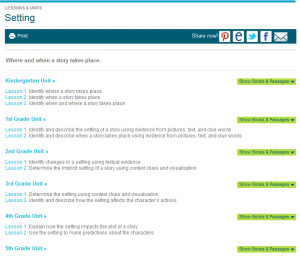Common Core Reading Lessons: Setting
 Where and when a story takes place.
Where and when a story takes place.
Setting Lessons - Covers kindergarten through sixth grade. Examples: Identify when and where a story takes place. Identify and describe when a story takes place using evidence from pictures, text, and clue words. Determine the implicit setting of a story using context clues and visualization. Identify and describe how the setting affects the character’s actions. Explain how the setting impacts the plot of a story.
Key Ideas and Details
K.RL.1. With prompting and support, ask and answer questions about key details in a text.
K.RL.2. With prompting and support, retell familiar stories, including key details.
K.RL.3. With prompting and support, identify characters, settings, and major events in a story.
Presentation of Knowledge and Ideas
K.SL.5. Add drawings or other visual displays to descriptions as desired to provide additional detail.
Key Ideas and Details
CCSS.ELA-Literacy.RL.1.1 Ask and answer questions about key details in a text.
CCSS.ELA-Literacy.RL.1.2 Retell stories, including key details, and demonstrate understanding of their central message or lesson.
CCSS.ELA-Literacy.RL.1.3 Describe characters, settings, and major events in a story, using key details.
Integration of Knowledge and Ideas
CCSS.ELA-Literacy.RL.1.7 Use illustrations and details in a story to describe its characters, setting, or events.
Fluency
CCSS.ELA-Literacy.RF.1.4 Read with sufficient accuracy and fluency to support comprehension.
CCSS.ELA-Literacy.RF.1.4c Use context to confirm or self-correct word recognition and understanding, rereading as necessary.
Vocabulary Acquisition and Use
CCSS.ELA-Literacy.L.1.4 Determine or clarify the meaning of unknown and multiple-meaning words and phrases based on grade 1 reading and content, choosing flexibly from an array of strategies.
CCSS.ELA-Literacy.L.1.4a Use sentence-level context as a clue to the meaning of a word or phrase.
Integration of Knowledge and Ideas
CCSS.ELA-Literacy.RL.2.7 Use information gained from the illustrations and words in a print or digital text to demonstrate understanding of its characters, setting, or plot.
Fluency
CCSS.ELA-Literacy.RF.2.4 Read with sufficient accuracy and fluency to support comprehension.
CCSS.ELA-Literacy.RF.2.4c Use context to confirm or self-correct word recognition and understanding, rereading as necessary.
Vocabulary Acquisition and Use
CCSS.ELA-Literacy.L.2.4 Determine or clarify the meaning of unknown and multiple-meaning words and phrases based on grade 2 reading and content, choosing flexibly from an array of strategies.
CCSS.ELA-Literacy.L.2.4a Use sentence-level context as a clue to the meaning of a word or phrase.
Key Ideas and Details
CCSS.ELA-Literacy.RL.3.1 Ask and answer questions to demonstrate understanding of a text, referring explicitly to the text as the basis for the answers.
CCSS.ELA-Literacy.RL.3.3 Describe characters in a story (e.g., their traits, motivations, or feelings) and explain how their actions contribute to the sequence of events.
Range of Reading and Level of Text Complexity
CCSS.ELA-Literacy.RL.3.10 By the end of the year, read and comprehend literature, including stories, dramas, and poetry, at the high end of the grades 2-3 text complexity band independently and proficiently.
Fluency
CCSS.ELA-Literacy.RF.3.4 Read with sufficient accuracy and fluency to support comprehension.
CCSS.ELA-Literacy.RF.3.4a Read on-level text with purpose and understanding.
CCSS.ELA-Literacy.RF.3.4c Use context to confirm or self-correct word recognition and understanding, rereading as necessary.
Comprehension and Collaboration
CCSS.ELA-Literacy.SL.3.2 Determine the main ideas and supporting details of a text read aloud or information presented in diverse media and formats, including visually, quantitatively, and orally.
Vocabulary Acquisition and Use
CCSS.ELA-Literacy.L.3.4 Determine or clarify the meaning of unknown and multiple-meaning word and phrases based on grade 3 reading and content, choosing flexibly from a range of strategies.
CCSS.ELA-Literacy.L.3.4a Use sentence-level context as a clue to the meaning of a word or phrase.
CCSS.ELA-Literacy.L.3.5 Demonstrate understanding of word relationships and nuances in word meanings.
CCSS.ELA-Literacy.L.3.5b Identify real-life connections between words and their use (e.g., describe people who are friendly or helpful).
CCSS.ELA-Literacy.L.3.6 Acquire and use accurately grade-appropriate conversational, general academic, and domain-specific words and phrases, including those that signal spatial and temporal relationships (e.g., After dinner that night we went looking for them).
Key Ideas and Details
CCSS.ELA-Literacy.RL.4.1 Refer to details and examples in a text when explaining what the text says explicitly and when drawing inferences from the text.
CCSS.ELA-Literacy.RL.4.2 Determine a theme of a story, drama, or poem from details in the text; summarize the text.
CCSS.ELA-Literacy.RL.4.3 Describe in depth a character, setting, or event in a story or drama, drawing on specific details in the text (e.g., a character's thoughts, words, or actions).
Research to Build and Present Knowledge
CCSS.ELA-Literacy.W.4.9 Draw evidence from literary or informational texts to support analysis, reflection, and research.
CCSS.ELA-Literacy.W.4.9a Apply grade 4 reading standards to literature (e.g., ''Describe in depth a character, setting, or event in a story or drama, drawing on specific details in the text [e.g., a character's thoughts, words, or actions].'').